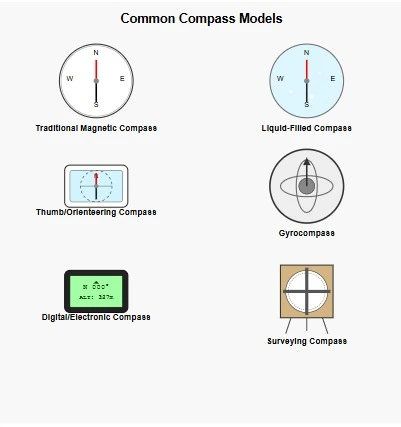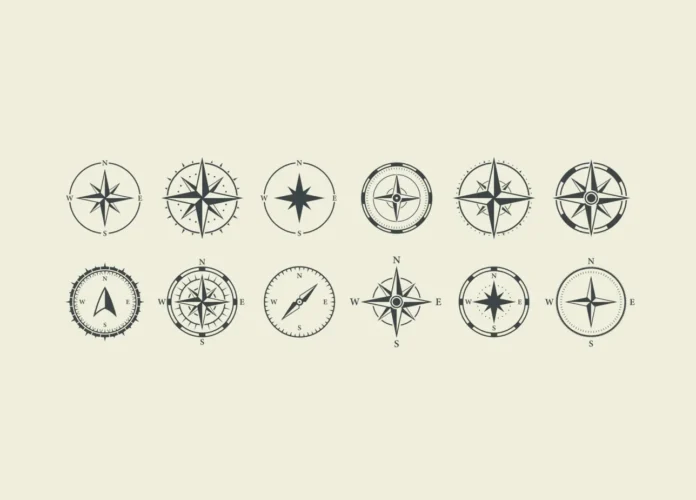The quest to answer “which way is north” led to one of humanity’s most revolutionary inventions. The compass, a device that transformed navigation and exploration forever, has a rich history spanning over two millennia.
The Evolution and Diversity of Compasses
Originating in China during the Han Dynasty (200 BCE – 200 CE), the compass began not as a navigational tool but as a divination instrument. These early models featured lodestone spoons rotating on bronze plates, primarily used for feng shui practices. It wasn’t until the Song Dynasty (1040-1044 CE) that the first documented navigational compass emerged—a magnetized needle floating on water. The technology gradually spread westward through maritime trade routes, reaching Europe by the 12th century.
Today’s compasses fall into several distinct categories. Traditional magnetic compasses, with their freely rotating needles aligned to Earth’s magnetic field, remain widely used and have evolved into variants including liquid-filled models for stability and thumb compasses for orienteering. The early 20th century introduced the gyrocompass, which uses Earth’s rotation rather than magnetism to find true north, proving invaluable for ships and aircraft. Modern electronic compasses employ magnetometers to provide digital readings, often integrated into smartphones and GPS devices.
For specialized applications, astronomical compasses use celestial bodies for orientation in polar regions, while precision surveying compasses feature sophisticated angle-measurement capabilities. Military personnel rely on robust lensatic compasses with sighting wires for tactical operations.
Among recreational users, the Suunto MC-2G and Silva Ranger S dominate the hiking market, while military operations favor the tritium-illuminated Cammenga 3H. Maritime navigation typically employs fluid-damped models like the Ritchie Explorer, and professionals in geology and forestry prefer precision instruments such as the Brunton Pocket Transit Geo. Digital options range from dedicated Bushnell devices to integrated Garmin Fenix watches.
This simple tool has transformed human mobility across history, evolving from a mystical device to an essential instrument for exploration, cartography, and navigation that continues to adapt with technological advancement.
Evolution of Early Designs
- The First Models
The earliest compass designs were remarkably simple yet ingenious. Chinese inventors created a spoon-shaped lodestone that, when placed on a flat surface, would consistently point south. This was followed by the “south-pointing fish,” which consisted of a magnetized iron fish floating in a bowl of water.
- Transition to Navigation
By the 11th century, the Chinese military began using compasses for land navigation, and by the 12th century, they had adapted them for maritime use. This marked a crucial transition from ceremonial to practical applications.
Types of Compasses
- Magnetic Compass
- The traditional compass using Earth’s magnetic field
- Variants include:
- Dry compass (needle on pivot)
- Liquid-filled compass (damped needle movement)
- Thumb compass (compact for orienteering)
- Marine compass (mounted on ships)
- Gyrocompass
- Invented in the early 20th century
- Uses a gyroscope and Earth’s rotation instead of magnetism
- Not affected by magnetic interference
- Mainly used in ships and aircraft
- Electronic/Digital Compass
- Modern version using magnetometers
- Often integrated into smartphones and GPS devices
- Can provide precise headings in digital format
- Astronomical Compass
- Uses celestial bodies (sun, stars) for orientation
- Examples include the solar compass and astrocompass
- Used when magnetic compasses are unreliable (polar regions)
- Surveying Compass
- Used for land surveying
- Often mounted on tripods for precision
- Examples include the circumferentor and alidade

The compass remains one of humanity’s most important navigational inventions, enabling reliable direction-finding across oceans and land, revolutionizing travel, exploration, and cartography throughout history.
Global Spread and Development
- Introduction to Europe
The compass reached Europe through Arab traders who had contact with Chinese civilization. By the 12th century, European mariners had adopted the magnetic compass, revolutionizing maritime navigation.
- Medieval Innovations
During the 13th century, significant improvements emerged:
- Mounting needles on pins within compass bowls
- Adding directional markings
- Introducing compass cards beneath needles
- Implementing gimbal mounting systems
Technical Advancements
- The Liquid Compass Revolution
A major breakthrough came in 1690 when Sir Edmond Halley introduced the first working model of a liquid compass. This innovation helped solve problems with needle stability and shock absorption.
- Modern Developments
By the early 20th century, several key improvements appeared:
- Liquid-filled compasses became standard
- Binnacle mounting systems were perfected
- Correction mechanisms for metal interference were developed
- Integration with gyroscopic technology
Impact on Human History
The compass’s invention catalyzed numerous historical achievements:
- Enabled safe ocean navigation
- Facilitated global trade routes
- Supported military operations
- Advanced scientific understanding of magnetism
Compass Development Timeline
| Era/Year | Compass Type | Inventor/Region | First Used By | Notable Facts |
|---|---|---|---|---|
| 2nd Century BCE | Lodestone Compass (Sinan) | Ancient China (Han Dynasty) | Chinese diviners | Used for geomancy and feng shui; shaped like a spoon that would rotate on a flat board |
| 1st Century CE | South-pointing chariot | Ancient China | Chinese authorities | Mechanical compass using differential gears; not magnetic |
| 1044 CE | Floating Needle Compass | Zheng He (China, Song Dynasty) | Chinese sailors | Magnetized needle floating on water; first documented maritime use |
| 1100s | Dry Pivot Compass | Unknown (China) | Chinese navigators | Needle mounted on a pivot; allowed for use on moving ships |
| 1190s | Marine Compass | Unknown | European sailors | Spread to Europe via Arab traders |
| 1269 | Dry Mariner’s Compass | Petrus Peregrinus (Europe) | European navigators | First detailed European documentation in “Epistola de Magnete” |
| 1300s | Compass Rose | Mediterranean sailors | Mediterranean navigators | Standardized directional system with 32 points |
| 1490s | Bearing Compass | Unknown (Europe) | European explorers | Used during the Age of Exploration; improved precision |
| Early 1500s | Surveying Compass | Unknown (Europe) | European surveyors | Used for land measurement and mapping |
| 1525 | Dry Card Compass | Unknown (Europe) | European sailors | Card attached to needle, rotating together |
| 1745 | Liquid-Filled Compass | Gowin Knight (England) | British Navy | Damped the needle’s movement; more stable on ships |
| 1813 | Surveyor’s Compass | W. & S. Jones (England) | Land surveyors | Precision instrument for measuring angles |
| 1885 | Lensatic Compass | Unknown (Europe) | Military personnel | Included sighting wire for precise bearings |
| 1908 | Gyrocompass | Elmer Sperry (USA) | US Navy | First practical gyrocompass; found true north |
| 1915 | Silva Compass (Baseplate) | Tillander brothers (Sweden) | Swedish orienteers | First modern orienteering compass with protractor baseplate |
| 1930s | Prismatic Compass | Unknown (Europe) | Military surveyors | Precise angle measurements with prism reading system |
| 1933 | Astrocompass | Unknown (Europe) | Polar explorers/aviators | Used celestial bodies instead of magnetism |
| 1950s | Thumb Compass | Silva (Sweden) | Sports orienteers | Compact design for quick reference while running |
| 1960s | Liquid-Damped Bearing Compass | Various manufacturers | Recreational hikers | Consumer models became widely available |
| 1970s | Electronic Fluxgate Compass | Various manufacturers | Marine industry | First electronic compass for boats |
| 1990s | Digital Compass | Various tech companies | General consumers | Electronic compasses become consumer products |
| 2000s | Smartphone Compass | Various tech companies | Smartphone users | Integrated into mobile devices with GPS |
| 2010s | Smart Compass Apps | Software developers | Smartphone users | Advanced features with augmented reality |
Legacy and Significance
The compass represents one of humanity’s most enduring inventions. From its humble beginnings as a divination tool to its role in modern navigation, it has continuously evolved while maintaining its fundamental purpose of providing reliable directional guidance.
Today, while GPS technology dominates navigation, the traditional compass remains an essential tool for outdoor enthusiasts, military personnel, and as a reliable backup system. Its invention marks a crucial milestone in human innovation, demonstrating how a simple concept can revolutionize civilization’s development.
The compass’s journey from ancient China to global adoption illustrates humanity’s persistent drive to explore, innovate, and understand our world better. Its legacy continues to influence modern navigation technology while remaining a testament to human ingenuity.
- Source: https://whichwayisnorth.online/
